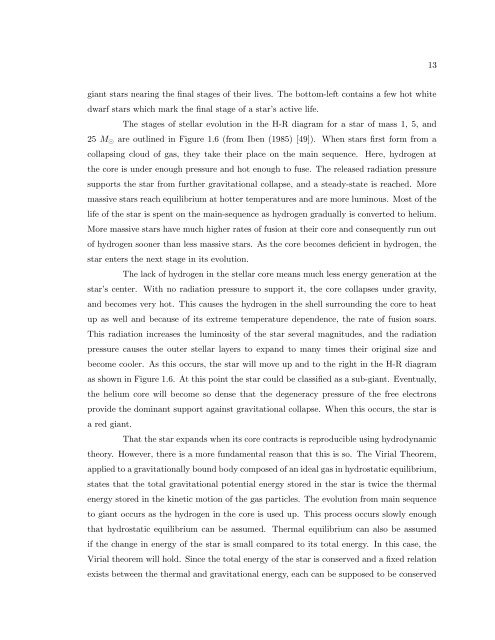The Size, Structure, and Variability of Late-Type Stars Measured ...
The Size, Structure, and Variability of Late-Type Stars Measured ...
The Size, Structure, and Variability of Late-Type Stars Measured ...
You also want an ePaper? Increase the reach of your titles
YUMPU automatically turns print PDFs into web optimized ePapers that Google loves.
13<br />
giant stars nearing the final stages <strong>of</strong> their lives. <strong>The</strong> bottom-left contains a few hot white<br />
dwarf stars which mark the final stage <strong>of</strong> a star’s active life.<br />
<strong>The</strong> stages <strong>of</strong> stellar evolution in the H-R diagram for a star <strong>of</strong> mass 1, 5, <strong>and</strong><br />
25 M ⊙ are outlined in Figure 1.6 (from Iben (1985) [49]). When stars first form from a<br />
collapsing cloud <strong>of</strong> gas, they take their place on the main sequence. Here, hydrogen at<br />
the core is under enough pressure <strong>and</strong> hot enough to fuse. <strong>The</strong> released radiation pressure<br />
supports the star from further gravitational collapse, <strong>and</strong> a steady-state is reached. More<br />
massive stars reach equilibrium at hotter temperatures <strong>and</strong> are more luminous. Most <strong>of</strong> the<br />
life <strong>of</strong> the star is spent on the main-sequence as hydrogen gradually is converted to helium.<br />
More massive stars have much higher rates <strong>of</strong> fusion at their core <strong>and</strong> consequently run out<br />
<strong>of</strong> hydrogen sooner than less massive stars. As the core becomes deficient in hydrogen, the<br />
star enters the next stage in its evolution.<br />
<strong>The</strong> lack <strong>of</strong> hydrogen in the stellar core means much less energy generation at the<br />
star’s center. With no radiation pressure to support it, the core collapses under gravity,<br />
<strong>and</strong> becomes very hot. This causes the hydrogen in the shell surrounding the core to heat<br />
up as well <strong>and</strong> because <strong>of</strong> its extreme temperature dependence, the rate <strong>of</strong> fusion soars.<br />
This radiation increases the luminosity <strong>of</strong> the star several magnitudes, <strong>and</strong> the radiation<br />
pressure causes the outer stellar layers to exp<strong>and</strong> to many times their original size <strong>and</strong><br />
become cooler. As this occurs, the star will move up <strong>and</strong> to the right in the H-R diagram<br />
as shown in Figure 1.6. At this point the star could be classified as a sub-giant. Eventually,<br />
the helium core will become so dense that the degeneracy pressure <strong>of</strong> the free electrons<br />
provide the dominant support against gravitational collapse. When this occurs, the star is<br />
a red giant.<br />
That the star exp<strong>and</strong>s when its core contracts is reproducible using hydrodynamic<br />
theory. However, there is a more fundamental reason that this is so. <strong>The</strong> Virial <strong>The</strong>orem,<br />
applied to a gravitationally bound body composed <strong>of</strong> an ideal gas in hydrostatic equilibrium,<br />
states that the total gravitational potential energy stored in the star is twice the thermal<br />
energy stored in the kinetic motion <strong>of</strong> the gas particles. <strong>The</strong> evolution from main sequence<br />
to giant occurs as the hydrogen in the core is used up. This process occurs slowly enough<br />
that hydrostatic equilibrium can be assumed. <strong>The</strong>rmal equilibrium can also be assumed<br />
if the change in energy <strong>of</strong> the star is small compared to its total energy. In this case, the<br />
Virial theorem will hold. Since the total energy <strong>of</strong> the star is conserved <strong>and</strong> a fixed relation<br />
exists between the thermal <strong>and</strong> gravitational energy, each can be supposed to be conserved













![Problem #1 [Structure Formation I: Radiation Era]](https://img.yumpu.com/37147371/1/190x245/problem-1-structure-formation-i-radiation-era.jpg?quality=85)


